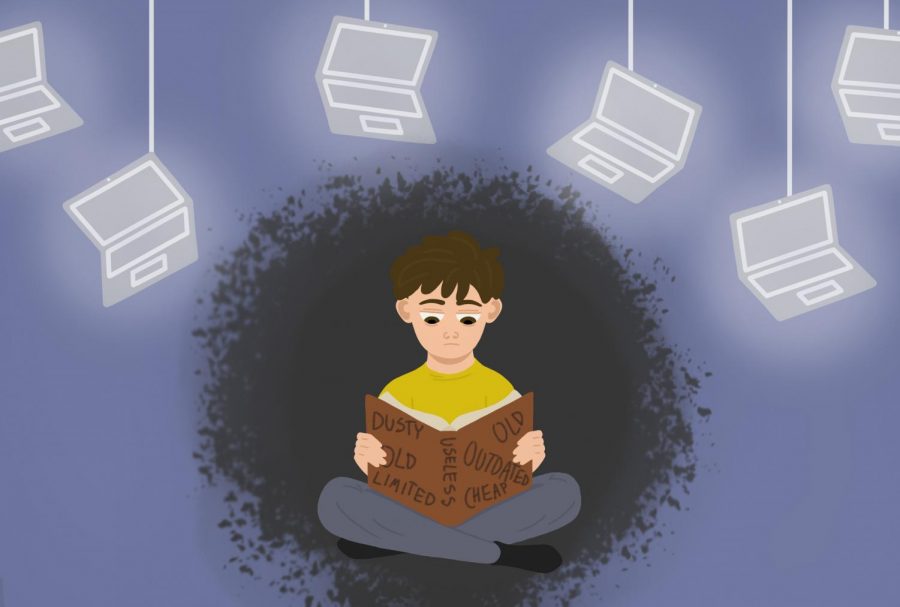Coronavirus Shines Light On District’s Need For Technology
April 29, 2020
On March 13th, 2020 students of Highland High left the building without knowing that they would not be returning for the rest of the school year. And for seniors, ever again.
Despite the growing concerns over the spread of COVID-19, or the ‘coronavirus,’ the end of the third term was approaching, and that seemed a much more pressing issue. Meanwhile, the Salt Lake City School District was coming to terms with the decision that their buildings were going to have to come to a temporary suspension.
By this point in time, other schools across the nation had already gone into a recess, switching to distance learning until further notice. Even other schools in Utah had switched, such as the Murray School District. So why wait?
For a district such as ours, the question was never of whether recess was a good idea, but rather a matter of accessibility. While it wasn’t the most ideal way to show it, the global pandemic has shined light on the district’s need for more technology.
Students of today are some of the first generations to grow up in a digital world. Technology has only advanced with time, and has made itself an integral part of our lives. And as of April 14th, it became vital for student success.
It is not a secret that Highland has struggled with technological access, especially when it comes to laptops. Kate Nisbet, a senior at Highland, has seen education slow down dramatically because of a lack of access.
“I’ve been in classes where lessons have been pushed over a week because we can’t get the computers,” Nisbet said. “We can’t continue to the next lesson until the last lesson is finished, so we’re forced to do busy work.”
Oftentimes, departments struggle to integrate technology into their lessons due to inaccessibility. There are too few computers and tablets for teachers to reliably mix traditional learning with online practices. This leads to teachers being less familiar with online resources that could positively impact their classrooms. Amid a crisis such as this, teachers’ access to these resources could greatly increase the efficiency of distance learning.
In addition, a more even split between traditional teaching and technology would have eased the transition into quarantine for students. The abrupt switch to online learning has created mass feelings of stress and a lack of motivation. Caitlin Bramble, a current freshman at Highland, agrees with this statement.
“The switch to online learning has been difficult for me and many others I’ve talked to,” Bramble said. “I think it’s really important that teachers and students are learning how to use online platforms…to the best of their abilities because they’re going to be used more frequently as this pandemic goes on.”
As distance learning became the new situation for schools, having a reliable way to connect to the internet reached top priority for students. Out of lack of technology during school arose the issue of access to computers at home.
“A lot of students don’t have great access to technology at home, making this switch to online learning even more difficult for them as it is for people like me,” Bramble said.
According to the Salt Lake City School District’s Low Income report for the 2019-20 school year, just under 40 percent of students at Highland fall into the ‘low income’ category. While this doesn’t give insight into the exact resources that each student has at home, it implies that a significant portion of Highland students could be struggling to access their schoolwork. In addition to this, with many parents being at home internet and computer access could be limited. Even as I write this article it is on a shared laptop with my family.
The Salt Lake School District allows each core department to buy new textbooks on a rotational schedule. This summer, the language arts department is supposed to purchase new textbooks, but the department would rather buy additional laptop carts for their classrooms. District rules prohibit this, only allowing the money to be spent on textbooks or it is unused.
This type of policy shows just how far behind the technology spectrum the district has fallen. Why spend money on textbooks that eventually gather dust when computers can be updated and used for so much more?
Many districts have a one-to-one student-to-computer ratio. This is why Murray District could move so quickly to an at-home format. Salt Lake needs to make technology more accessible.
To combat this issue, SLCSD allowed for their equipment to be borrowed by students. This is coupled with many internet providers giving their services to families in need to ensure success throughout these difficult times. While this solution may work for now, it has been made clear that there needs to be a change.
Distance learning has shown that technology is a beneficial element in the classroom, and is a savior in times of need. This period of time now could forever reshape the way educators use online resources for their practice, but only if it is treated as such.
“I think it would be great if we implemented online learning still once this is all over,” Bramble said. “I hope by then, we will have all of the resources and websites figured out and use them to our own advantage.”
While it unfortunately took a global pandemic to highlight this issue, one can only hope that the Salt Lake City School District will reevaluate their distribution of funding.




























